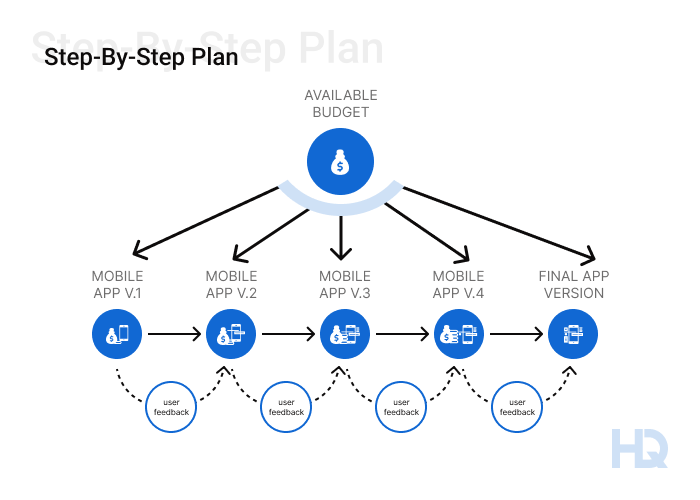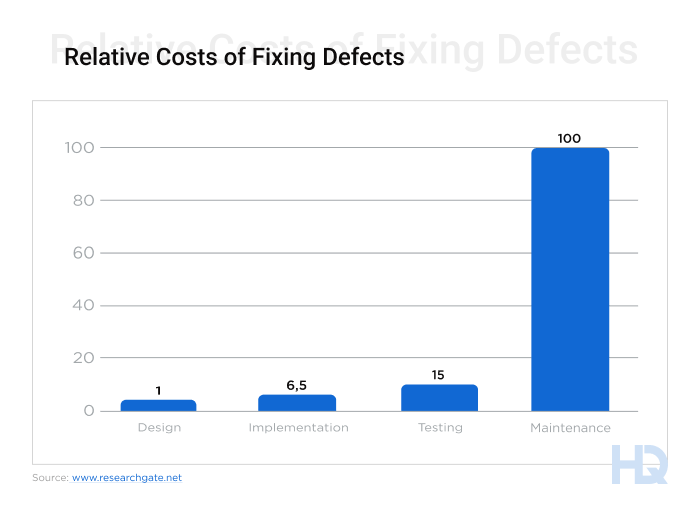Why does Mobile App Development Cost So Much?
Ways to Reduce Startup App Development Costs
Focus on step-by-step development
Choosing an outsourced app development
The main challenge almost every entrepreneur faces is the cost of starting a startup, often with a severely restricted or even nonexistent budget, especially at the initial stage. The available budget must be stretched beyond app development to cover employee salaries, marketing activities, etc.
Therefore, startups need to create a competitive mobile app at a reasonable price. The first question startups worry about is: how much does it cost to develop an app? Then they try to find tricks for optimizing the cost of building an app without sacrificing the quality of the finished product.
Why does Mobile App Development Cost So Much?
Ways to Reduce Startup App Development Costs
Focus on step-by-step development
Choosing an outsourced app development
Over the years, we’ve identified proven ways to reduce app expenses, and we’ll share them below. But before getting into ways to cut costs, it’s important to understand what influences the final price of your application.
The final cost of app development varies greatly from app to app, as it’s affected by numerous factors that fall roughly into two categories: functional and organizational costs.

The first type includes expenses associated with the technical part of app implementation:
The second type of cost is related to the organization of the app development work, primarily the engineering team. It’s necessary to determine the skills of team members and the size of the team, which may include:
Another important decision is to choose between outsourcing and an in-house development team. With the latter, expenses will include recruitment, wages, vacations, benefits, and etc. As for outsourcing, these costs are on the vendor’s side, which enables a startup to easily scale the development team up and down and find specialists with required skills quickly.
When working with an outsourcing team, a startup should also take into account the location of developers. For example, the hourly rates of specialists from the USA are much higher than those from Estonia.
Want to build a mobile app? We’re ready to help!HQSoftware has a team of skilled professionals ready to tackle the project. Let’s talk!
Anna Halias
Business Development Manager,
HQSoftware
So, each factor described above brings additional development costs, adding up to a higher price. We’ve already mentioned two factors that can help reduce startup app development costs. Now, let’s delve deeper into cost-reduction strategies.
The first step to reducing the cost of app development for a startup can be deployed even before actual development starts. The product owner needs to define the vision for the app and create a product requirement document that outlines all the specifications for the future application.
This helps the creator and developers stay on the same page during the project, plan a budget and timeline, and avoid additional costs when making changes to the original concept. Moreover, the more detailed a description the product owner provides before kick-off, the more predictable the result.
An MVP, or a Minimum Viable Product, is a pilot version of an app that includes only several core features. It allows startups to assess the business idea, understand whether an app fits the market, and minimize startup risks.
How can MVP development help reduce app costs? First and foremost, an MVP helps to analyze how well an app meets customer needs. This enables startups to avoid creating a product that is not marketable and wasting their budget.
For example, instead of building a complex and time-consuming feature right away, an organization can create a beta version and identify whether app users actually need it. If it turns out that the feature isn’t badly required, then a business can focus on building something that is really in demand.
After launching an MVP, a startup can even interview some app users to learn more about the strengths and weaknesses of the product and create a plan for how to improve it.
Moreover, since the cost of an MVP app is less than that of a full-fledged solution, a startup can gain early adopters and earn its first profits with minimal investment. The profit, in turn, can be used for further app development. Yes, it may not reduce the total cost, but the app will already work for itself, so a business won’t have to raise much more additional investment.
One of the most crucial mistakes of startups is deciding to launch a full-fledged app immediately. It sometimes happens that users don’t need all the functionality being offered. Or they need features that the organization may not even have guessed at. All of these may result in having to rebuild the solution, which requires huge additional costs.
To avoid this, startups should have a step-by-step plan, which implies splitting app development into several versions. It’s necessary to prioritize the required features and decide which version should include them. Such an approach helps a business allocate available resources more effectively, monitor and manage the project budget, and reduce additional expenses.

Besides, after releasing each version, a company should re-analyze user behavior and needs to adjust the plan for the next version.
Step-by-step development also helps a team be more productive. This can be achieved by using Agile methodologies, specifically Scrum, which provides a transparent development process. Thus, the development team gets timely feedback and can make adjustments during development, rather than upon completion.
In addition, instead of trying to build all the features in the shortest possible time, which may decrease the app’s quality, engineers can focus on a specific scope of work. This helps avoid bugs, which reduces reworking time as well as overall costs.
Outsourcing app development helps startups save costs in multiple ways:
In this way, an organization gets an experienced team with relevant skills that knows how to work with startups both to maintain high quality and save as many resources as possible. Such a team understands the importance of thorough work and eliminates any faults before the product launch.
According to statistics, fixing errors in the maintenance stage can cost 100 times more than doing so in the design and implementation steps. That’s why QA engineers play a highly important role in saving on the cost of app development.

Testing code units is an ongoing process that, for greatest efficiency, should be carried out from the beginning. Of course, developers also conduct some testing, but they are responsible only for their part of the work. A QA engineer, in contrast, can assess the whole product’s performance as well as its parts.
Cross-platform development is an approach to engineering a mobile app that is compatible with both Android and iOS platforms. To create a cross-platform app, developers use a single code base and common API. This can involve HTML5, JavaScript, CSS languages and Flutter, React Native, or some other frameworks.
With such an approach, a business can reach a broader audience and avoid the extra costs of building two separate apps. Cross-platform development offers even more advantages:
With all its benefits, such an approach also has some disadvantages:
Whether these disadvantages are critical depends on app requirements and business goals. For example, if a startup needs an app with a specific set of functions that require integration with numerous device features, it’s better to choose two separate apps and start by developing a version for only one platform. But if there are no specific requirements, cross-platform development helps to greatly reduce the app development cost.
There are several reasons for starting with just a few built-in features to reduce app development costs.
First, not all devices are the same and possess similar features. So, a certain percentage of the target audience may not be able to use the full app functionality due to device limitations. Secondly, not every app requires interactions with as many mobile features as possible. For example, a learning app is unlikely to need a GPS connection.
So, a startup should determine which mobile features are really necessary for the app right now, which features can be added later, and which ones can be skipped entirely. This avoids wasting time and resources on unnecessary work while focusing on essential functionality.
A startup doesn’t need to create the whole app functionality from scratch. Instead, it may use some existing third-party libraries, which simplifies and speeds up development while reducing the cost of building an app. For example, developers can integrate a third-party ordering system or use open-source code to create a dashboard, instead of spending time and resources on building such components from scratch.
But that doesn’t mean that the entire application has to be a constructor, assembled from pre-existing parts. It’s up to developers to decide whether to use a ready-made solution or create a new module. And the more experienced the developer is, the more sound the decision is going to be.
At first, it may seem appealing to create a design with lots of visual elements to impress users. But if the startup aims to reduce expenses, it makes more sense to focus on usability rather than looks. That’s why lots of apps offer minimalistic designs to avoid additional costs.
It’s also important to carefully consider all the possible scenarios in interactions and try to minimize the number of separate screens and tabs. The user journey shouldn’t be long and complex, with many steps involved, as this may only confuse users. Instead, an app should be intuitive and user-friendly. In this way, a startup can both increase user retention and reduce app development costs.
During development, the original app concept can undergo numerous changes, which can increase the time needed to build the project. So, it makes no sense to rush the development team and sacrifice quality for the sake of speed. The pressure and hurry can become distracting, leading to more mistakes and redoing efforts.
Thus, it is important for a startup not only to keep track of deadlines but also to remain flexible and time-smart to get a high-quality application that meets all business needs.
Although it can’t be said that app development is cheap, there are many ways to reduce its final price. This mostly depends on choosing a reliable and experienced software team, which helps to avoid redoing work and reduces additional costs.
HQSoftware specialists have been working with startups at various stages for more than 20 years, so we have accumulated a collection of best practices that help us find a balance between business ambitions and allocated resources. With our app development services for startups, we are ready to meet almost any request, providing high-quality solutions, meeting deadlines, and minimizing app development costs.

Head of Production
To ensure the outstanding quality of HQSoftware’s solutions and services, I took the position of Head of Production and manager of the Quality Assurance department. Turn to me with any questions regarding our tech expertise.
We are open to seeing your business needs and determining the best solution. Complete this form, and receive a free personalized proposal from your dedicated manager.

Sergei Vardomatski
Founder